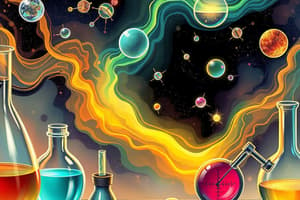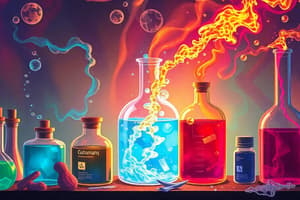Podcast
Questions and Answers
What is the most abundant element in living things?
What is the most abundant element in living things?
- Oxygen
- Hydrogen (correct)
- Nitrogen
- Carbon
Which statement correctly defines an isomer?
Which statement correctly defines an isomer?
- An atom that has gained or lost electrons
- A compound made solely of covalent bonds
- A molecule with a different number of atoms
- A compound with the same molecular formula but different structural arrangement (correct)
What happens when an element gives up an electron?
What happens when an element gives up an electron?
- It becomes a cation. (correct)
- It becomes stable regardless of charge.
- It becomes an anion.
- It remains neutral.
What distinguishes ionic bonding from covalent bonding?
What distinguishes ionic bonding from covalent bonding?
Which property of water is primarily due to hydrogen bonding?
Which property of water is primarily due to hydrogen bonding?
How do valence electrons determine the stability of an atom?
How do valence electrons determine the stability of an atom?
What is defined as a neutral pH?
What is defined as a neutral pH?
What is the role of water in plant vasculature?
What is the role of water in plant vasculature?
What is the primary structure of a protein?
What is the primary structure of a protein?
Which statement describes saturated fats?
Which statement describes saturated fats?
What happens to a plant cell in a hypotonic solution?
What happens to a plant cell in a hypotonic solution?
Which of the following is NOT a property of enzymes?
Which of the following is NOT a property of enzymes?
Which of the following best describes osmosis?
Which of the following best describes osmosis?
What are channel proteins primarily used for?
What are channel proteins primarily used for?
What is true about the plasma membrane?
What is true about the plasma membrane?
Which statement accurately describes prokaryotes?
Which statement accurately describes prokaryotes?
What product is produced during the light-dependent reactions of photosynthesis?
What product is produced during the light-dependent reactions of photosynthesis?
Which stage of cellular respiration occurs in the mitochondria and produces the highest amount of ATP?
Which stage of cellular respiration occurs in the mitochondria and produces the highest amount of ATP?
Which type of RNA carries the genetic code from DNA to the ribosome for protein synthesis?
Which type of RNA carries the genetic code from DNA to the ribosome for protein synthesis?
During transcription, which enzyme synthesizes the mRNA molecule?
During transcription, which enzyme synthesizes the mRNA molecule?
What is the primary role of tRNA in the process of translation?
What is the primary role of tRNA in the process of translation?
What is a common concern regarding genetically modified organisms (GMOs)?
What is a common concern regarding genetically modified organisms (GMOs)?
What happens during the critical phase of the cell cycle known as interphase?
What happens during the critical phase of the cell cycle known as interphase?
What is the charge of DNA, and how does it influence its movement in gel electrophoresis?
What is the charge of DNA, and how does it influence its movement in gel electrophoresis?
Flashcards
Scientific Method Steps
Scientific Method Steps
A systematic way of acquiring knowledge through observation, experimentation, and analysis.
Independent Variable
Independent Variable
The variable that is intentionally changed in an experiment.
Dependent Variable
Dependent Variable
The variable that is measured or observed to see the effect of the independent variable.
CHON elements
CHON elements
Signup and view all the flashcards
Most abundant Element in living things
Most abundant Element in living things
Signup and view all the flashcards
Isotope
Isotope
Signup and view all the flashcards
Ionic vs Covalent Bonds
Ionic vs Covalent Bonds
Signup and view all the flashcards
Hydrogen Bond
Hydrogen Bond
Signup and view all the flashcards
Macromolecule structure
Macromolecule structure
Signup and view all the flashcards
Enzyme properties
Enzyme properties
Signup and view all the flashcards
Plasma membrane layers
Plasma membrane layers
Signup and view all the flashcards
Diffusion factors
Diffusion factors
Signup and view all the flashcards
Hypotonic solution
Hypotonic solution
Signup and view all the flashcards
Protein structure levels
Protein structure levels
Signup and view all the flashcards
Photosynthesis equation
Photosynthesis equation
Signup and view all the flashcards
Organelle functions
Organelle functions
Signup and view all the flashcards
Light-dependent reaction materials
Light-dependent reaction materials
Signup and view all the flashcards
Cellular Respiration Equation
Cellular Respiration Equation
Signup and view all the flashcards
DNA vs. RNA
DNA vs. RNA
Signup and view all the flashcards
Transcription location
Transcription location
Signup and view all the flashcards
Codon definition
Codon definition
Signup and view all the flashcards
Translation location
Translation location
Signup and view all the flashcards
Restriction Enzyme
Restriction Enzyme
Signup and view all the flashcards
Mitosis stages
Mitosis stages
Signup and view all the flashcards
Study Notes
Scientific Method
- List the steps of the Scientific Method.
- Apply the Scientific Method to an experimental situation.
- Define independent and dependent variables in an experiment.
Chemistry Basics
- Define CHON and the most abundant element in living things.
- Identify the element all organic molecules contain.
- State the charge (and mass) of protons, neutrons, and electrons.
- Determine the number of protons, neutrons, and electrons for an element given the periodic table.
- Explain how valence electrons are assigned.
- Differentiate between stable and unstable atoms/elements.
- Define an isotope.
- Differentiate between a molecule and a compound.
- Identify molecules and compounds given a formula.
- Define an isomer (refer to Chapter 3).
- Explain ionic and covalent bonding.
- Explain electron gain and loss.
- Explain electron sharing (equal/unequal).
- Define hydrogen bonding, its properties (e.g., heat capacity, evaporation), and its importance.
Properties of Water
- Explain hydrogen bonding in water.
- Describe the properties of water (e.g., high heat capacity, high heat of vaporization, good solvent).
- Explain water's role in adhesion, cohesion, and transport in plants.
- Define acidic pH, basic pH, and neutral pH.
- Describe how pH is maintained.
Organic Molecules
- Explain how organic molecules are formed and broken down.
- Identify elements of each biomolecule.
- Describe the monomers (building blocks) for each.
- Describe the polymers for each class of biomolecules.
- List examples of each biomolecule.
- Describe the functions of each biomolecule.
- Differentiate between saturated and unsaturated lipids.
- Explain the different levels of protein organization (primary, secondary, tertiary, quaternary).
Biochemistry
- List (and define) the properties of enzymes.
- Explain how enzymes bind to substrates.
- Identify factors affecting enzyme function.
- Discuss differences between prokaryotic and eukaryotic cells and their organelles.
- Describe the structure and function of the plasma membrane.
- Explain the movement of molecules across the plasma membrane.
- Describe diffusion and osmosis.
- Explain hypotonic, isotonic, and hypertonic solutions.
- Discuss kinetic and potential energy.
- Explain the laws of thermodynamics.
- Define photosynthesis; its reactants and products and locations.
- Elaborate on the process of cellular respiration.
- Detail the stages of cellular respiration (reactants, products, location, ATP production).
Cellular Biology & Genetics
- Explain biotechnology, its basic steps, and its applications.
- Describe restriction enzymes and PCR.
- Describe plasmids.
- Describe CRISPR.
- Explain the concerns regarding GMOs (genetically modified organisms).
- Explain how to read a DNA gel picture.
- Describe the cell cycle (interphase and mitosis), including apoptosis.
- Differentiate between benign and malignant tumors.
- Define haploid/diploid, and the chromosome numbers.
- Describe homologous chromosomes.
- Describe meiosis, including synapsis, crossing over, and the laws of independent assortment and segregation.
- Explain nondisjunction and related disorders.
- Define P1, F1, and F2 generations.
- Describe genotype/phenotype, dominant/recessive traits, and genetic disorders.
- Describe the process of transcription (DNA to mRNA).
- Explain the process of translation including ribosome sites.
- Describe the pathway for protein synthesis (mRNA, nuclear pore, ribosomes, release).
Studying That Suits You
Use AI to generate personalized quizzes and flashcards to suit your learning preferences.




